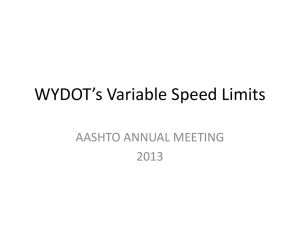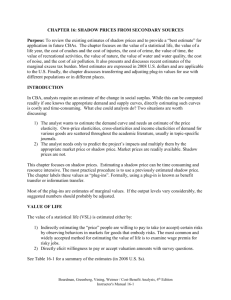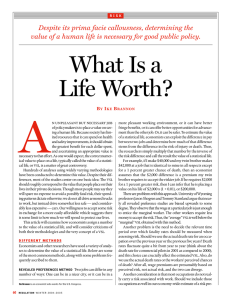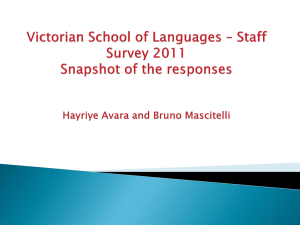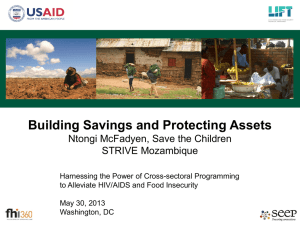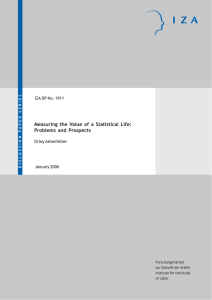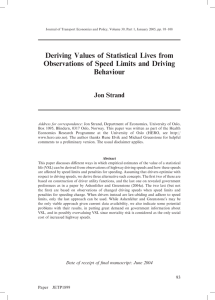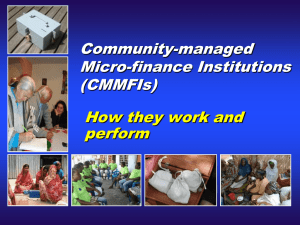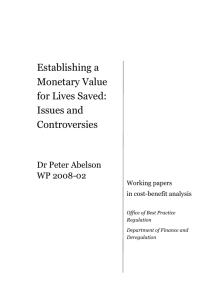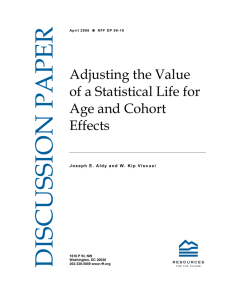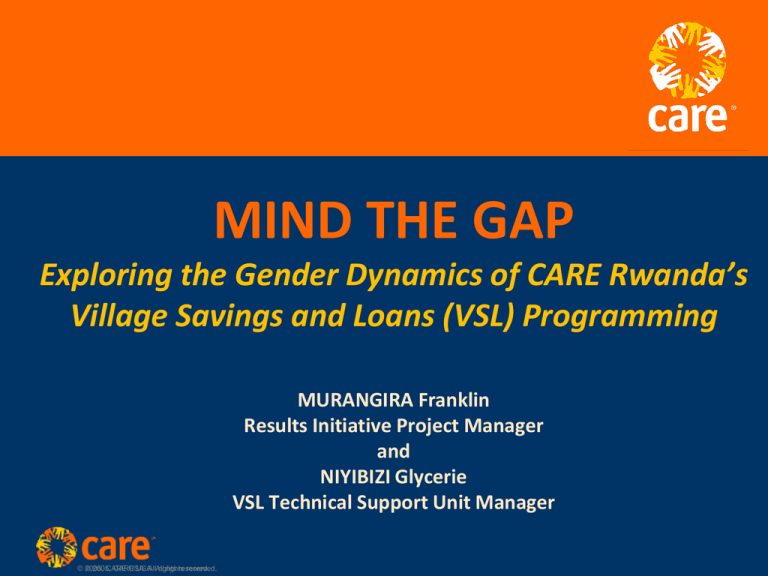
MIND THE GAP
Exploring the Gender Dynamics of CARE Rwanda’s
Village Savings and Loans (VSL) Programming
MURANGIRA Franklin
Results Initiative Project Manager
and
NIYIBIZI Glycerie
VSL Technical Support Unit Manager
© 2005,
© 2005,
CARE
CARE
USA.
USA.
AllAll
rights
rights
reserved.
reserved.
PRESENTATION OUTLINE
Introduction
Goal
and objectives
Methodology
Key findings
Recommendations
© 2005, CARE USA. All rights reserved.
INTRODUCTION
© 2005, CARE USA. All rights reserved.
Background: SAFI and RI PROJECTS
SAFI Project Objectives
To enhance the livelihood security and financial
literacy of at least 108,200 Village Savings and Loans
Group (VSL GROUP) members, 70% of whom are
women
RI Project Objectives (Family Planning Results Initiative)
To improve sexual, reproductive and maternal health
(SRMH) by strengthening health systems as well as
addressing the inequitable gender roles and social
norms that influence SRMH, especially family
planning
© 2005, CARE USA. All rights reserved.
The SAFI-RI Integration Model
SAFI mid-term review – suggested the need to address
gender, power relations, communication at household
RI mid-term review - suggested that RI is contributing to more
communication, more shared decision-making, more men and
women sharing household duties and acceptance of FP
So, the CO decided to…..
Select high impact activities from RI to integrate into VSLA
groups, to address these gaps (Explore and challenge gender
norms using SAA, family planning posts, engaging religious
leaders as partners and allies for gender equity and SRMH)
Goal – To develop/document a model for VSL as a platform
for integrated programming (VSL, SRMH and Gender Equity)
© 2005, CARE USA. All rights reserved.
© 2005, CARE USA. All rights reserved.
GOAL AND OBJECTIVES OF THE GGA
© 2005, CARE USA. All rights reserved.
THE GOAL OF THE GGA
To examine the process and outcomes of our
VSL programming through a gender lens in
order to strengthen the VSL methodology as a
programming platform for CARE-Rwanda’s
women’s empowerment program
To identify opportunities to strengthen the
integrated SAFI-RI programmatic initiative
© 2005, CARE USA. All rights reserved.
CARE
INTERNATIONAL’S
CASE OF
FORTHE
CHANGE
THE
SPECIFIC
OBJECTIVES
GGA
To learn how gender norms shape women’s
participation in and benefits from VSL groups
To understand the different experiences of
men and women participating in VSL groups
To formulate recommendations for
strengthening the VSL methodology to
address issues relating to gender dynamics
© 2005, CARE USA. All rights reserved.
METHODOLOGY
© 2005, CARE USA. All rights reserved.
PROCESS OUTLINE
© 2005, CARE USA. All rights reserved.
FOCUS GROUP DISCUSSIONS
CARE staff served as data collectors
Single sex teams with single sex groups
2 hours on average
© 2005, CARE USA. All rights reserved.
KEY FINDINGS
© 2005, CARE USA. All rights reserved.
THE 6 THEMES OF INQUIRY
1.
2.
3.
4.
5.
6.
Access: How VSL group members obtain the money they
need for saving?
Priorities: How VSL group members want to use the loans
and savings they get from the group?
Decision-making: How VSL group members make decisions
about the use of their loans and savings?
Control of Assets from Loans: To what extent VSL group
members have control over the assets they purchase using
loans from the group?
Benefits, Challenges and Barriers: What have been the
benefits and challenges of participating in the VLS group?
Ideas for Improvement: How could the working of the VSL
group be further improved?
© 2005, CARE USA. All rights reserved.
KEY FINDINGS
Normative gender roles and inequitable power relations
between men and women significantly constrain women’s
ability to fully participate in VSL and benefit enough from
the VSL methodology
Women tend to invest either in improved household wellbeing (through consumption-related expenditures) or in
relatively small-scale business activities, while men tend to
make larger scale business investments that generate
higher levels of income, which suggests that women may
also benefit proportionately less in economic terms than
men from their participation in the VSL group
© 2005, CARE USA. All rights reserved.
KEY FINDINGS CONTINUED
Women’s participation in the VSL group is limited by social
norms mostly their widespread dependency on their
husbands for money and household basic needs
satisfaction
Men are controlling the functioning of the VSL groups, even
if they are not members of those groups
Women do not feel comfortable or confident in taking
decisions about a loan (whether to take one, how much to
borrow, what to use the money for) without their
husband’s approval
Men have rigid expectations of the gender role of women
© 2005, CARE USA. All rights reserved.
RECOMMENDATIONS
© 2005, CARE USA. All rights reserved.
RECOMMENDATIONS
Review and strengthen the various training process of the
VSL methodology (e.g. the SPM and financial education
modules) to ensure that they are gender sensitive
Train peer educators within VSL groups to facilitate
reflection/discussion about gender and power relations
and on how restrictive gender roles and inequitable power
relations adversely affect health and well-being
Build skills for communication, negotiation and decisionmaking with VSL members and their spouses
Integrate this critical reflection about gender roles + skills
building activities to build communication/negotiation skills
early in the VSL cycle
© 2005, CARE USA. All rights reserved.
RECOMMENDATIONS CONTINUED
Constructive engagement with men to share
information/address concerns about VSL and to
explore/challenge restrictive gender norms
To promote dialogue and debate on gender issues at
the wider level of the community using different
forms of media and SAA activities in churches, school
and during community work (Umuganda)
© 2005, CARE USA. All rights reserved.
ACCESS AFRICA LEARNING EVENT
Presentation,
reports and
video shared
at AA
meeting last
week and
the following
next steps
were agreed
on……..
© 2005, CARE USA. All rights reserved.
NEXT STEPS FROM AA LEARNING EVENT
1.
2.
3.
To conduct similar GGAs in a sample of
countries in Africa where VSL programming is
being implemented so that the consolidated
findings feed into the development of the
proposed gender and empowerment training
module
For AA to take the lead next FY in reviewing the
VSL manuals to be more gender sensitive
For AA to ensure that VSL programs incorporate
a gender transformative approach
© 2005, CARE USA. All rights reserved.
FOR ADDITIONAL INFORMATION SEE……
© 2005, CARE USA. All rights reserved.
FOR ADDITIONAL INFORMATION SEE……
SAFI-RI integration video documentation:
http://www.youtube.com/watch?v=HSDEFRqvvJk
Gender wiki:
http://gender.care2share.wikispaces.net/
© 2005, CARE USA. All rights reserved.

